

English Language Garden Site Map. English Language Garden Site Map. Phonétique et Phonologie: Documents de travail - Guy Spielmann. Common Core Phonics & Word Recognition Activities - Learning Resources® Language Arts. Language Arts. Instruction Matters: Spelling of Vowels by Children in England and the US. What is magic e? Split digraphs explained for parents. Helping your child learn to read with phonics is all very well at the beginning: “c – a – t.

Cat”. Simple. Mrs. Judy Araujo, Reading Specialist. Syllables are the beats that compose a word when you speak it. 16_syllable_rules.cwk_(WP)_ SyllablesMadeSimpleAGuide Syllabication Rules WHY STUDY SYLLABLES?
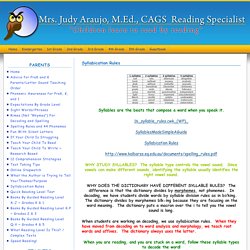
The syllable type controls the vowel sound. WHY DOES THE DICTIONARY HAVE DIFFERENT SYLLABLE RULES? When students are working on decoding, we use syllabication rules. When you are reading, and you are stuck on a word, follow these syllable types to decode the word! 1. Blends & Consonant Clusters. Consonant clusters or blends, are the names given to two or three consonants that appear together in a word.

Each consonant retains its sound when blended. The term cluster refers to the written form and the term blend refers to the spoken form. English Spelling Patterns and Spelling Reform with Phonics. English spelling is needlessly difficult, which is why spelling reform is needed.

English orthography shood be easier to read, lern, and use. However, we don't hav to create anything that is extremely phonetic. Just update the current system of English spelling used by many peeple. Feeling bright great and proud r consonant blends activity. Crash Course in Phonics, part 2 – The Classroom Key. Introduction to English Vowels — Pronuncian: American English Pronunciation. Diphthongs, Modified Vowels and Vowel Digraphs. Vowel-Consonant (CVC) pattern. Vowelpatternsall. Consonants — Discourse Functional Grammar. There are three factors that affect how American English consonants are produced.
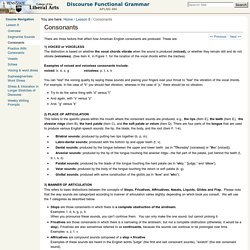
These are: 1) VOICED or VOICELESSThe distinction is based on whether the vocal chords vibrate when the sound is produced (voiced), or whether they remain still and do not vibrate (voiceless). (See item K. in Figure 1. for the location of the vocal chords within the trachea). Examples of voiced and voiceless consonants include:voiced: b, d, z, g voiceless: p, t, s, k You can “test” the voicing quality by saying these sounds and placing your fingers over your throat to “feel” the vibration of the vocal chords.
Try to do the same thing with “d” versus “t”And again, with “s” versus “z”And, “g” versus “k” Greek Phonology. In this chapter, I will attempt to describe the Greek phonemes without introducing the Greek letters (except for a handful used for notational purposes) and their pronunciation, which is the object of the following chapters.
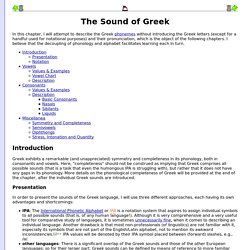
I believe that the decoupling of phonology and alphabet facilitates learning each in turn. Introduction Greek exhibits a remarkable (and unappreciated) symmetry and completeness in its phonology, both in consonants and vowels. Definition and Examples of Consonant Clusters. Definition In linguistics, a consonant cluster (CC) is a group of two or more consonant sounds that come before (onset), after (coda), or between (medial) vowels.
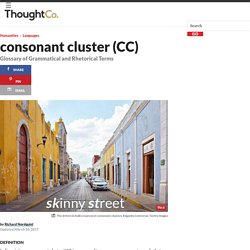
Also known simply as cluster. The ESL: COMPLEX VOWELS AND VOWEL COMPLEXES: DIPHTHONGS AND TRIPHTHONGS. 1.

Diphthongs A. Definition - a diphthong (Greek: diphthongos, literally "two sounds" or "two tones"), also known as a gliding vowel, refers to two adjacent vowel sounds occurring within the same syllable. Diphthong is a sound which consist of a movement or glide from one vowel to another. Apartado 4 0. Free Phonics Lessons. American English: Clusters, Digraph, Blends, and Diphthongs. Clusters of either consonants or vowels add to the challenge of beginning reading learner.

Sometimes the clustered letters each make a sound, in which case early readers can apply phonetic decoding strategies to read them. However, other combinations make new or unexpected sounds that must be actively taught separately. Long vowel spelling patterns. Vowel Clusters. VOWEL PAIRS or CLUSTERS. The VOWEL CLUSTERS Activity: The pronunciation of vowel pairs in the left column below, can be studied and practised at AntWise© HEAR the AUDIO version in Windows Media Player.
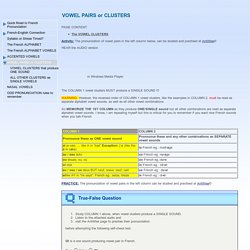
The COLUMN 1 vowel clusters MUST produce a SINGLE SOUND !!! WARNING: However, the reversed order of COLUMN 1 vowel clusters, like the examples in COLUMN 2, must be read as separate alphabet vowel sounds, as well as all other vowel combinations. Short vowel charts. Podcasts — Pronuncian: American English Pronunciation. Transcript Hi again, and welcome back to Seattle Learning Academy's American English pronunciation podcast. My name is Mandy, and this is our 206th episode. Today I want to talk about the contraction I'd, (I-apostrophe-e) which can be used to contract either I would or I had. I notice that some contractions are embraced by non-native speakers much more than others. For instance, many of my students willingly use don't for do not, or won't for will not. One of the biggest benefits of using contractions is that they help the rhythm of your spoken English sound more fluent.
Let me be absolutely clear that the contractions for both of these words is I'd, pronounced exactly the same. An Index of Phonic Patterns by Vowel Types. Freebies > Articles > An Index of Basic Phonic Patterns by Vowel Types from The Teaching of Reading: a Continuum from Kindergarten through College Use this index to locate additional rimes (word families) that illustrate phonic principles taught in any reading series.
The following charts list various phonic patterns or word families associated with specific vowel patterns. To make it as easy as possible for a teacher or diagnostician to use, we have listed the most common patterns and arranged them according to the basic fourteen vowel phonemes in English.